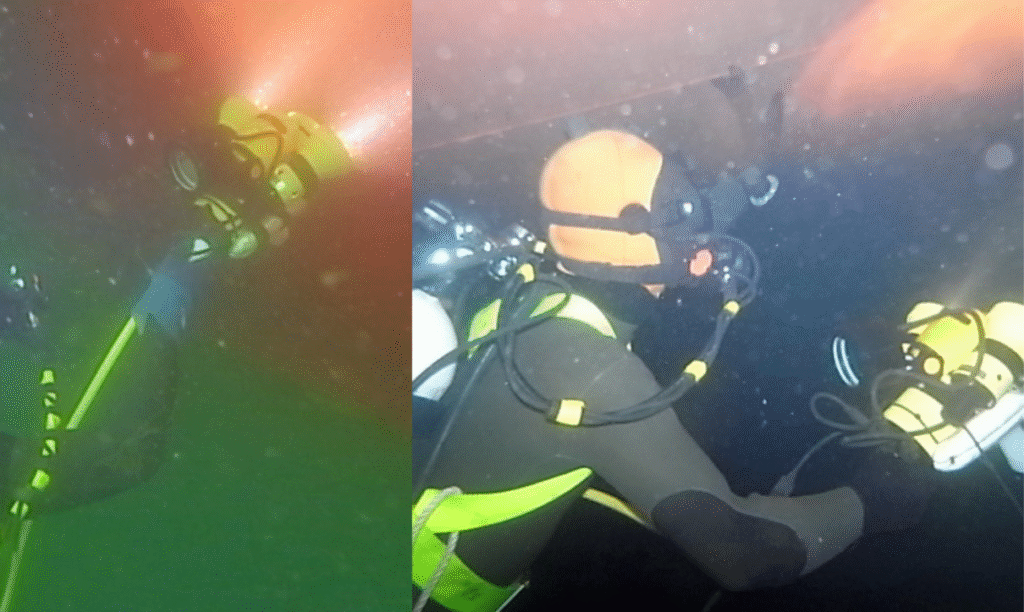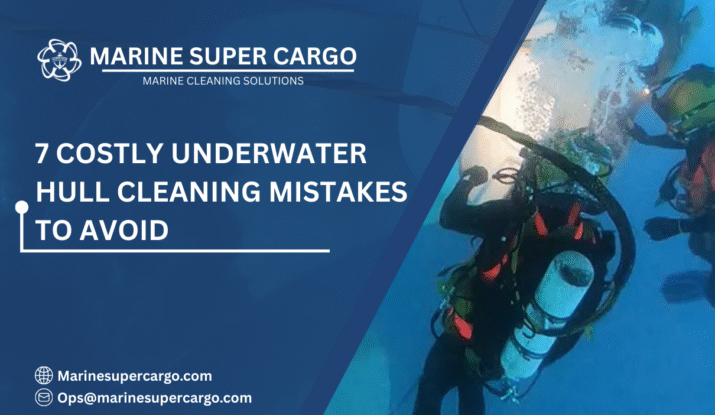When you picture underwater hull cleaning mistakes, you might imagine a diver with a brush and a scrub pad working to get rid of the slimy buildup on a ship’s belly. Simple enough, right? But in reality, underwater hull cleaning is riddled with hidden complexities. Just like bathing a giant steel whale, small errors can snowball into massive costs, regulatory troubles, and environmental risks.
In this article, we’ll dive deep into the most common underwater hull cleaning mistakes that ship operators make. You’ll see why these missteps happen, their consequences, and—most importantly—how to avoid them. Whether you’re a shipowner, manager, or operator, this guide will help you steer clear of pitfalls and keep your fleet efficient, compliant, and sustainable.
Why Underwater Hull Cleaning Mistakes Matter
Hull cleaning isn’t just about appearance—it’s a critical practice for efficiency, safety, and compliance. Here’s why:
- Fuel efficiency: A fouled hull increases drag, raising fuel consumption by 15–40%. Many Underwater Hull Cleaning Mistakes, such as delayed cleaning, directly worsen fuel costs.
- Compliance: International bodies like the IMO and port authorities now scrutinize hull fouling closely. Underwater Hull Cleaning Mistakes that release pollutants or spread invasive species can result in penalties and detentions.
- Maintenance: Routine cleaning reduces corrosion risks and extends hull lifespan. Poor practices or Underwater Hull Cleaning Mistakes can damage coatings, leading to costly repairs.
- Environmental protection: Proper cleaning prevents invasive species from spreading and safeguards marine ecosystems.
Skipping or mishandling hull cleaning is like ignoring the oil light on your car—it always costs more in the long run.

The Hidden Risks Behind Mistakes
When mistakes are made underwater, they’re not always visible right away. Some remain hidden until:
- Fuel bills creep up.
- Hull coatings wear down prematurely.
- Ports impose fines or detentions.
- The ecosystem suffers irreparable harm.
That’s why it’s so important to understand what these underwater hull cleaning mistakes are.
1. Ignoring Niche Areas
One of the most common Underwater Hull Cleaning Mistakes is focusing only on the vessel’s flat surfaces while overlooking critical niche areas. Spaces such as sea chests, propeller shafts, rudder horns, and intake grates are ideal hiding places for biofouling organisms.
Mistake: Cleaning only the visible, flat sections of the hull.
Consequence: Unnoticed invasive species hitch rides to new ecosystems, and vessels risk failing inspections due to overlooked fouling.
Solution: Avoid Underwater Hull Cleaning Mistakes by adopting thorough protocols that target niche areas with specialized tools.
Think of these areas as the “nooks and crannies” in your kitchen—if you only wipe the counters but ignore the corners, bacteria still thrive. Addressing niche zones prevents costly Underwater Hull Cleaning Mistakes and ensures full compliance.
2. Choosing the Wrong Cleaning Tools
Not all brushes and scrubbing devices are created equal. Using overly aggressive tools can strip antifouling coatings, while using weak or inappropriate equipment leaves behind stubborn fouling.
- Mistake: One-size-fits-all tools for every part of the hull.
- Consequence: Increased maintenance costs and reduced coating life.
- Solution: Match tool aggressiveness to hull coating type, consulting coatings specialists when needed.
3. Skipping Waste Capture Systems
Traditional underwater hull cleaning often releases biofouling waste directly into the surrounding waters. This can spread invasive species and cause pollution—leading to potential noncompliance under IMO guidelines and national laws.
- Mistake: Cleaning without capturing debris.
- Consequence: Ports may issue fines, detain vessels, or ban operators.
- Solution: Use closed-loop cleaning systems that vacuum and filter waste during operations.
Imagine dusting your living room without a vacuum—sure, the dust is off the couch, but now it’s everywhere. Also, read about underwater hull cleaning in Cochin.
4. Cleaning at the Wrong Time
Timing matters. Cleaning during unsuitable conditions—such as in heavily trafficked ports, sensitive ecosystems, or extreme water temperatures—can do more harm than good.
- Mistake: Scheduling cleaning based purely on vessel convenience.
- Consequence: Fouling organisms may spread to vulnerable areas, or cleaning may fail to remove mature growth.
- Solution: Base schedules on voyage plans, coatings’ lifespan, and environmental risk zones.
✅ 4 Things to Check for Safety at Sea pic.twitter.com/dAxhJQ2i6U
— Marine Super Cargo (@Marinsupercargo) September 14, 2025
5. Overcleaning the Hull
Yes, there is such a thing as cleaning too often. Frequent aggressive cleaning can damage coatings, accelerating corrosion and increasing repainting costs.
- Mistake: “Scrub it cleaner” mentality.
- Consequence: Increased downtime and higher lifecycle costs.
- Solution: Balance cleaning frequency with antifouling coating performance and vessel speed profiles.
Think of it like polishing your car every week—you’ll wear away the paint before its time.
6. Overlooking Crew and Diver Training
Even with the best tools, poorly trained divers or crew can create mistakes. Complex hull structures, coating requirements, and environmental rules demand specialized training.
- Mistake: Relying on untrained contractors or under-skilled divers.
- Consequence: Missed fouling areas, coating damage, or regulatory breaches.
- Solution: Hire certified professionals with current training per IMCA and recognized marine safety standards.
7. Ignoring Biofouling Management Plans
Biofouling isn’t just about “scraping off slime.” The IMO encourages ships to maintain a formal Biofouling Management Plan (BFMP). Without one, cleaning becomes inconsistent and reactive.
- Mistake: Treating hull cleaning as a routine task with no strategy.
- Consequence: Regulatory headaches and higher long-term costs.
- Solution: Adopt BFMPs aligned with IMO and IAPH guidelines for consistency and accountability.
The Role of Regulations in Mistake Prevention
The maritime industry isn’t operating in a vacuum. Regulations such as:
- IMO Biofouling Guidelines (2011)
- MARPOL Convention (Annex V)
- Port-specific rules (New Zealand, Australia, and others)
make compliance non-negotiable. Mistakes in underwater hull cleaning now have legal and financial consequences, not just operational ones.
Environmental Fallout of Mistakes
When things go wrong underwater, ecosystems pay the price.
- Invasive species disrupt marine biodiversity.
- Fouling increases emissions due to fuel inefficiency.
- Scraping without waste capture adds pollutants straight into the ocean.
Every underwater hull cleaning mistake is like opening the gates for problems—ecological, regulatory, and financial. Also read
Cost Implications of Mistakes
Let’s put it into perspective:
- A 10% rise in fuel use from fouling can add millions in annual operating costs.
- One compliance fine or detained vessel could equate to months of routine maintenance expenses.
- Degraded coatings accelerate dry-docking needs.
In other words, mistakes don’t just “cost a little”—they can snowball into massive budget hits.
Technology and Solutions for the Future
Fortunately, innovations are changing the game:
- Robotic hull cleaners reduce diver errors and collect waste.
- Eco-friendly antifouling coatings improve resistance to biofouling.
- AI-based inspections help detect fouling problems early.
- Closed-loop cleaning systems stop invasive species from being released into new waters.
The future of hull cleaning is moving toward sustainability and precision.

Avoiding the Trap of Complacency
The biggest underlying mistake? Thinking “good enough” is enough. Hull cleaning in today’s regulatory and ecological climate demands professional standards, smart strategies, and modern tools. Complacency, even in small areas, is the pathway to cascading problems.
Conclusion
Three vital takeaways stand out:
- Small underwater hull cleaning mistakes can have enormous financial and ecological costs.
- Prevention is rooted in training, waste capture, and compliance-focused strategies.
- Investing in modern technology and Biofouling Management Plans is the smartest path forward.
If you’re serious about preventing costly mistakes and ensuring your fleet stays compliant, efficient, and eco-friendly, explore trusted solutions available at CleanShip.co. The cost of prevention is always lower than the cost of mistakes.
FAQs:
Q1. What are the most common underwater hull cleaning mistakes?
Overlooking niche areas, skipping waste capture systems, overcleaning, and poor diver training rank as the top mistakes ship operators should avoid.
Q2. How do underwater hull cleaning mistakes affect compliance?
They can lead to regulations breaches, port detentions, fines, and even trading restrictions for vessels that transport invasive species.
Q3. Can overcleaning damage ship hulls?
Yes. Too much scrubbing strips coatings, accelerates corrosion, and increases long-term dry-docking and recoating expenses.
Q4. Why is waste capture important in hull cleaning?
Without capture, fouling debris spreads invasive species and pollutants into ecosystems—one of the most serious compliance risks.
Q5. What innovations reduce hull cleaning mistakes today?
Robotic cleaners, eco-friendly coatings, closed-loop systems, and AI-driven inspections are leading solutions in the market.


